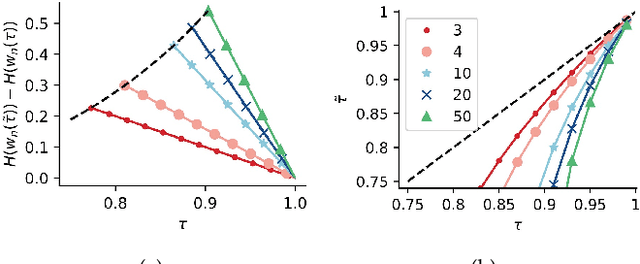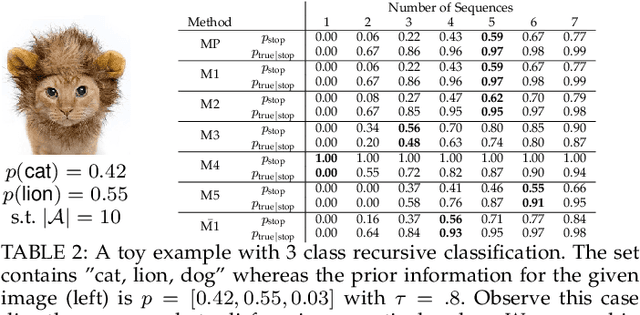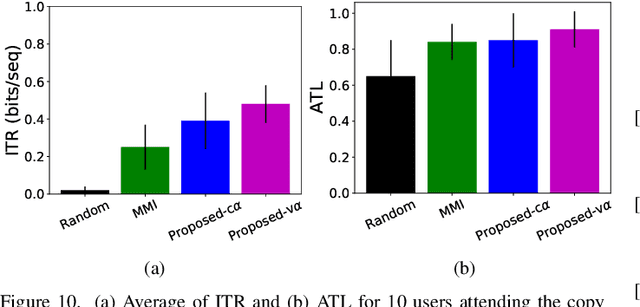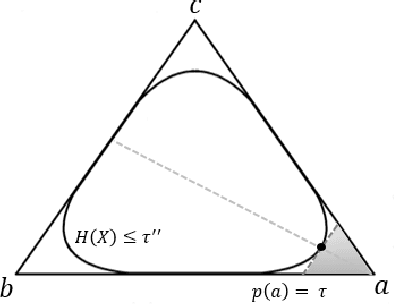Aziz Kocanaogullari
Recursive Estimation of User Intent from Noninvasive Electroencephalography using Discriminative Models
Oct 29, 2022Abstract:We study the problem of inferring user intent from noninvasive electroencephalography (EEG) to restore communication for people with severe speech and physical impairments (SSPI). The focus of this work is improving the estimation of posterior symbol probabilities in a typing task. At each iteration of the typing procedure, a subset of symbols is chosen for the next query based on the current probability estimate. Evidence about the user's response is collected from event-related potentials (ERP) in order to update symbol probabilities, until one symbol exceeds a predefined confidence threshold. We provide a graphical model describing this task, and derive a recursive Bayesian update rule based on a discriminative probability over label vectors for each query, which we approximate using a neural network classifier. We evaluate the proposed method in a simulated typing task and show that it outperforms previous approaches based on generative modeling.
Stopping Criterion Design for Recursive Bayesian Classification: Analysis and Decision Geometry
Jul 30, 2020



Abstract:Systems that are based on recursive Bayesian updates for classification limit the cost of evidence collection through certain stopping/termination criteria and accordingly enforce decision making. Conventionally, two termination criteria based on pre-defined thresholds over (i) the maximum of the state posterior distribution; and (ii) the state posterior uncertainty are commonly used. In this paper, we propose a geometric interpretation over the state posterior progression and accordingly we provide a point-by-point analysis over the disadvantages of using such conventional termination criteria. For example, through the proposed geometric interpretation we show that confidence thresholds defined over maximum of the state posteriors suffer from stiffness that results in unnecessary evidence collection whereas uncertainty based thresholding methods are fragile to number of categories and terminate prematurely if some state candidates are already discovered to be unfavorable. Moreover, both types of termination methods neglect the evolution of posterior updates. We then propose a new stopping/termination criterion with a geometrical insight to overcome the limitations of these conventional methods and provide a comparison in terms of decision accuracy and speed. We validate our claims using simulations and using real experimental data obtained through a brain computer interfaced typing system.
Active Recursive Bayesian Inference with Posterior Trajectory Analysis Using $α$-Divergence
Apr 07, 2020



Abstract:Recursive Bayesian inference (RBI) provides optimal Bayesian latent variable estimates in real-time settings with streaming noisy observations. Active RBI attempts to effectively select queries that lead to more informative observations to rapidly reduce uncertainty until a confident decision is made. However, typically the optimality objectives of inference and query mechanisms are not jointly selected. Furthermore, conventional active querying methods stagger due to misleading prior information. Motivated by information theoretic approaches, we propose an active RBI framework with unified inference and query selection steps through Renyi entropy and $\alpha$-divergence. We also propose a new objective based on Renyi entropy and its changes called Momentum that encourages exploration for misleading prior cases. The proposed active RBI framework is applied to the trajectory of the posterior changes in the probability simplex that provides a coordinated active querying and decision making with specified confidence. Under certain assumptions, we analytically demonstrate that the proposed approach outperforms conventional methods such as mutual information by allowing the selections of unlikely events. We present empirical and experimental performance evaluations on two applications: restaurant recommendation and brain-computer interface (BCI) typing systems.
 Add to Chrome
Add to Chrome Add to Firefox
Add to Firefox Add to Edge
Add to Edge